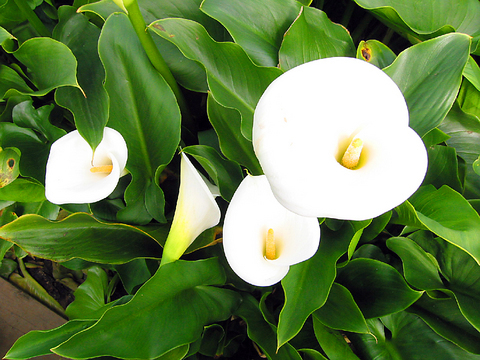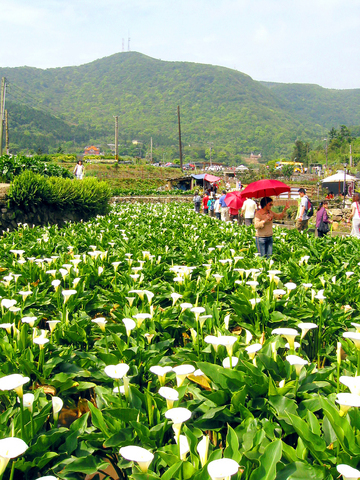Of the millions of calla lilies produced in Taiwan each year, more than half grow on farms near Bamboo Lake (Zhuzihu,
Traffic problems aside, it's hard to imagine a better setting for wholesome family entertainment so close to Taipei. Most come to pick bunches of the long-stemmed calla lilies, a relative of the taro that thrives in the cooler mountain climate. Others come to watch their children look for tadpoles in the muddy furrows or chase butterflies through the fields.
"It's like another world," said Hung Yi-wen (

"It's so romantic," sighed Cindy Chen, a college student who was visiting for the first time. She came to escape the bustle of the city and breathe the mountain air. This year's calla lily festival winds up this weekend and offers a variety of activities, including a photography contest, guided ecological tours and mini concerts.
Last year the event drew half a million visitors, according to the Beitou Farmer's Association and Taipei City government. Organizers expect a similar number to attend this year.
"We have so many visitors I can't even count them," said Mrs. Cheng , who runs the Trail Calla Lily Garden (

PHOTOS: RON BROWNLOW, TAIPEI TIMES
Like most establishments, Cheng's serves drinks on a shady patio and charges NT$100 per person for entry. Here, the fee allows visitors to pick a bunch of 10 flowers. Cheng also sells individual flowers for NT$10 from a roadside stand.
The government encourages visitors to take public transportation up the mountain during the calla lily festival. Although several buses stop near Zhuzihu Road, a circular route that connects the calla lily farms, only the Small No. 9 (
Nestled between Datun (
Outside Mau-bang Garden (
"We grow about 400,000 flowers a year," Gao said. To his right, a television played an instructional video on how to pick calla lilies. Gao said a flower picked in cooler weather can last up to 20 days at home. Trim the stalk every day and put it in a vase filled with a few ice cubes and several centimeters of water.
Some of the farms remain open after the official end of cally lily season. Goa said Mau-bang Garden closes in May and reopens from July to September for sunflower season.
To get there take the MRT to Beitou Station and transfer to the Small 9 bus.

Most heroes are remembered for the battles they fought. Taiwan’s Black Bat Squadron is remembered for flying into Chinese airspace 838 times between 1953 and 1967, and for the 148 men whose sacrifice bought the intelligence that kept Taiwan secure. Two-thirds of the squadron died carrying out missions most people wouldn’t learn about for another 40 years. The squadron lost 15 aircraft and 148 crew members over those 14 years, making it the deadliest unit in Taiwan’s military history by casualty rate. They flew at night, often at low altitudes, straight into some of the most heavily defended airspace in Asia.

Taiwan’s democracy is at risk. Be very alarmed. This is not a drill. The current constitutional crisis progressed slowly, then suddenly. Political tensions, partisan hostility and emotions are all running high right when cool heads and calm negotiation are most needed. Oxford defines brinkmanship as: “The art or practice of pursuing a dangerous policy to the limits of safety before stopping, especially in politics.” It says the term comes from a quote from a 1956 Cold War interview with then-American Secretary of State John Foster Dulles, when he said: ‘The ability to get to the verge without getting into the war is

Like much in the world today, theater has experienced major disruptions over the six years since COVID-19. The pandemic, the war in Ukraine and social media have created a new normal of geopolitical and information uncertainty, and the performing arts are not immune to these effects. “Ten years ago people wanted to come to the theater to engage with important issues, but now the Internet allows them to engage with those issues powerfully and immediately,” said Faith Tan, programming director of the Esplanade in Singapore, speaking last week in Japan. “One reaction to unpredictability has been a renewed emphasis on

Beijing’s ironic, abusive tantrums aimed at Japan since Japanese Prime Minister Sanae Takaichi publicly stated that a Taiwan contingency would be an existential crisis for Japan, have revealed for all the world to see that the People’s Republic of China (PRC) lusts after Okinawa. We all owe Takaichi a debt of thanks for getting the PRC to make that public. The PRC and its netizens, taking their cue from the Chinese Communist Party (CCP), are presenting Okinawa by mirroring the claims about Taiwan. Official PRC propaganda organs began to wax lyrical about Okinawa’s “unsettled status” beginning last month. A Global